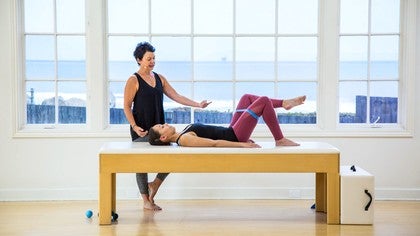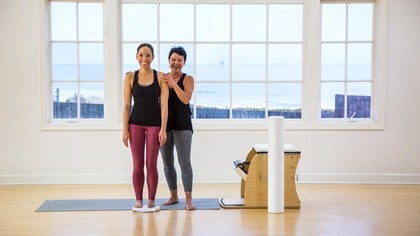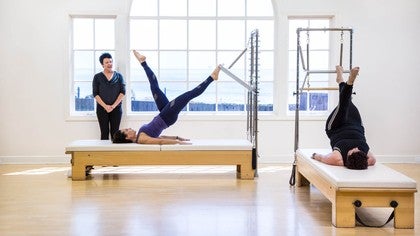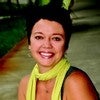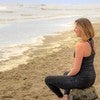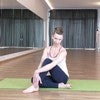Description
About This Video
Transcript
Read Full Transcript
Hi everybody. I'm Karen [inaudible] and I'm here with Jia. And uh, I'm here today to do a tutorial in three parts actually. Um, we're going to be looking at some of the common, um, deviations that we see in lower extremity alignment. Um, we're going to be looking at Valgus knee. We're going to be looking at Verus SNI, which could either both be structural or also just like a, a real tendency during movement. And then in the third part, um, we'll be looking at hyperextension and some strategies mean we might want to take to sort of address hyperextension. Um, so I want to sort of start by just giving you a little bit of a point of view about how we sort of assess a look at these, um, structural variations that we see in our clients. And first of all, I just want to remind us all that it's really easy when we see somebody and they come in and there's, you know, they've got this sort of deviation in their alignment.
Their legs maybe look like this or maybe they're, they look like this or they're really hyper extended, you know, and we think right away, oh, you know, I need to fix their alignment, right? I need them to stand. So they're, they're, you know, centered in their legs, which, which there's truth in the fact that we do want to train people to work, um, closer to a neutral centered position. But I want to remind us all that the structure of the person has to be sort of our guiding principle. So it's not always going to look like it comes right to center, depending on how, um, how change the structure is. Right? So we're going to be looking at, you know, depending on the person, right? And we, we don't really have all these kinds of legs in the studio.
We have some great hyperextension from Jia, which we're going to look at. She's going to sort of help model some of these other tendencies. But, um, but I want to remind you that we want to, we want to be, um, coaching people towards, uh, a centered position of the leg but not forcing them. And we also want to allow for the reality that life is not always in perfect alignment. So we're training people in, in center alignment. Um, but we're also, there's also a ton of sports that has ton of activities that people do where they need to go into these strained positions. And part of training them in good alignment is so that they can be actually prepared to be in these off-centered leg positions. Um, so I just wanted to start with just remembering like a soft lens on correcting alignment and then we're going to give you some movement protocols that across the board are going to be really, really safe and productive protocols to address these deviations that we're talking about today. So let's start with looking at valgus knee and valgus strain.
We're going to be looking first at how we just, some ways we might want to address and coach people who have, uh, a valgus knee or a valgus movement tendency. Right? So let's describe what Valgus is first of all right. So thou, this is a fancy word for knock need variation, right? So you know, a gea doesn't have knock these, but we're going to sort of just show you what generally happens in a valgus leg. So in a valgus or an invalid, this knee is that you'll see the two knees coming towards each other towards center line and they'll cross midline. And you're also gonna see much more internal rotation, which is part of this inward rotation. So the kneecaps will also often be facing each other and you're going to see a lot of variation in the foot. And good you can relax sweetheart, cause that's probably not comfortable, right? Um, when you're going to see a lot of variations in the put, sometimes you'll see the foot collapse into, to a sort of untwisted position.
Sometimes you'll see the person trying to force their foot back out, but you're going to notice something awkward about the feet. And I'm going to actually suggest that instead of really obsessing on getting their foot aligned, we're going to go ahead and address some of maybe the weaknesses up top and make sure the foot is just really, really supple and able to mobilize in all directions so it can start to build strength as the corrections are occurring from above. Um, okay, so how do we know what this person, you know, what's going on with this person, right? Are they just lazy and they tend to do this or they actually structurally have this variation? Or is it just something during the load that's really complicated? Um, it's going to be hard to figure that out. Okay. And let's say his plot, he's professionals. What we need to know is that if it, no matter what it is, whether it's fully structural or whether or not it's a movement tendency or somewhere in between the protocols, we're gonna offer it today are going to be able to help address that regardless, right? But what it does mean is when you're trying to get somebody to come out of this type of position, let's say you're trying to get them to do external rotation and that becomes their Max external rotation, you're not going to start asking them for more, right?
Are going to follow the structure. We're going to let alignment be determined by what's available to the leg. And um, we're going to train really good movement. Um, but let's just talk about for a second how you might assess somebody who doesn't have like an obvious structural variation, but they tend to strain in that direction, right? So I'm going to have gis sit down on this box. This is one way we could do it, but while you're watching your client and maybe you notice that they collapse in a little or the foot rolls in, you might want to just have them sit down low. This is pretty low. So your older clients might not be able to sit this low.
The reform is actually a good platform for this. And then I'm going watch her transfer up to standing. I'm going to ask her to try to keep this, or maybe I'm not even gonna ask her for it. Just have her go ahead and step up and let's see what her tendency is, right? So she actually is great. She doesn't do that. But let's see what, let's have you go into a valgus strain as you get up.
So watch what happens with their knees here, right? They click in together, she rolls in, right? This is what we would call like a valgus tendency when you're loading the leg, right? And so you're going to see this also when people lunge. So if you have somebody go into a launch, you're going to see this a lot of the time. As a matter of fact, is going to do this a little because on one leg, the center of gravity actually falls in the middle of, in the inside of the knee. So everybody's going to benefit on one leg from working. These strategies we're gonna talk about now, but there are a lot of people who are legs are not that conditioned, who aren't aware and need you to be able to describe to them, go up and do that valgus strain. Again, how to control that, right? So let's take a guess what, what muscles do we think are probably a little bit weaker here, right? Right. Lateral hip, right?
And what else did she's doing is internally rotating. So we want to start to pump up those external rotators ab doctors and I'm going to suggest that we also make sure that the foot is got a good mobility and a little bit of controls who are talking about motor control across the block here, um, as well as strength. So let's get started. All right, we're now going to, I'm just giving you just a little bit of protocols to start off with and then you guys as professionals can come up with a ton of other stuff. All of these exercises are in my, um, the mat class, the chair class and the tower class that are called hips, hip, knee, foot strengthening classes, um, that we just filmed 2018 in the spring. So you'll see these exercises here in the tutorial and then you get to be able to practice them and multilevels in those courses, you're going to take a towel and you're gonna roll it up. Um, and I also just want to mention that actually all of this material, the protocols that we're giving a little taste of here come from an education platform that I share with a colleague named Jeremy Lavadour. It's called movement science made simple.
So at this material's interesting to you. You could always like get in deeper with us or in real time. Um, but we love doing this here. So I'm rolled up this towel for Jia and I'm going to have her stand on this towel with her right foot first. And you guys can do this as for a little longer than we're going to do it here, but I just want to teach you the strategy. She's going to pick up her back leg and bring it just a little bit behind her and she's going to try to keep the front of her hips in extension he owl so she can put her hands on the creases of the front of her a little lower and just make sure she's keeping that hip extension.
And then she just working to balance right. And what you see here, um, and is how much wobble there is in this foot down here. Right? This is what we're going for is getting that twist and untwist of the foot to get the muscles really active in the foot. AndG is having to work her lateral hip like crazy to stand on one leg, aren't you honey? Yeah. So she's really getting a lot of variation here. We need this range in the foot to help correct some of these deviations we're talking about. So, um, great. So that's, I, I just love this exercise. Um, as a sort of start up point for thinking about alignment and then of course you would do it on the other leg, but for time we're going to move to the second standing variation. Um, so then I, I'm borrowing this and I said this on the, in the class from a yoga teacher named Tiffany Cruickshank who I take with but she doesn't know I take with her cause I take with her online. But, um, anyway, I thought this was great. I'm sure many people teach this. G is now we're going to stand on this. Let's do your other leg, right?
It's going to balance you out. And um, there's three parts to this. You're going to start standing on the yoga block and she's going to drop her right hip vis-a-vis. I'm just going to move this hand so you can see B VCV dropping into this hip and then she's going to pick that up, right? And then she's going to drop and pick it up. So I'm trying to encourage her not to pick it up from her waistline, but to really pick it up right there for, yeah, that's it.
And then once she has it picked up, her feet will be about the same level. She's going to start to slowly just swing. And I want her to do it in a way where she's not actually being such a good dancer like she is right now. But to let it just actually kind of like a pendulum, just hang down here, right to the leg is going to kind of swing forward and back. It's important that it swings a little bit back.
It's important that she doesn't fall into the lateral hip of this side and she's just gonna let that leg swing and the swinging of the leg is creating a lot of work for the supporting leg to again control. So part of what we're doing here as motor control and then she can do little circles again, sh less less dancer Leigh and more kind of just pendulum swinging there. She goes, right. And I like to stay and she can go the other way and I like to try to stay in this her bout a minute or more until I really feel my lateral hip fatigue. Okay, great. And so step on down. Did you feel that working in there? Yeah.
Great. So now let's just think about who we're talking about, right? We're talking about people who are potentially knock need, right? Which GE is. And so we're looking at a really aligned leg, right? So we may see a little bit of collapsing and a variation in the leg here, right? And, and again, we're going to try to have that person think about center of the hip center of the knee, of the foot, but we're also going to let them be, maybe their foot will be, you know, a little bit off that line, right? We're not going to force the structure, we're going to rely on the movement and the strengthening of that hip to help kind of prepare them for living with the structure they have.
All right, we're going to go up to the table and do some ab duction. Okay. So now we've, we just did a little bit of foot mobility. We just did a little hip stability. Um, now I'm just going to make a recommendation for a little bit Ab duction external rotation activity, which is be in this whole series. Okay. And um, you guys can really put your mind to this. You could add this circle theraband to footwork on the machine to standing up and down on the low chair. You can, you can add it to lots of exercises. Cause what we're trying to do is just make sure this person whose legs tend to fall inward, right, are doing a little bit more of an outward motion and a little bit more of an external rotation. So we're going to slide this on.
This is also in your mat class for the legs and hip. So it's like a real, it's a real a like full platter if you follow the whole sequence. So she's going to start with this and we could do a shoulder bridge. So let's go up into a shoulder bridge first. Now your valgus person's knees are gonna want to collapse here, right?
Cause they're in load. So they're going to have to push out to make that correction. So this feedback is going to give them an opportunity and then she can roll down and when she's rolling down, she's going to have to keep that little out movement. Yeah. Fantastic. Right? So you can bridge, you could do a couple of those. You could do a series with those. Um, another place you're going to see that fall in is when somebody goes into something like a knee fold.
So we're gonna practice that knee fold also with the theraband. One of the things I love about this exercise is she has to ab Dick Ab dog on her supporting leg as well as her gesture leg. Right? So she can alternate that. And again, she's trying to think of center of the hip center of the knee, center of the foot. Right? And She's controlling with both side hips that tendency to fall in. Right? She already has that tendency and the band is creating that tendency.
So she's having to really work against it. Right. And then you could add on here guys, and you could think about this yourself, but she could come up and she could do some little circles, right? She could come, she could have this knee bent and go into a, this is actually one of my personal favorites, is to go into a little bit of external rotation, Ab duction here and back again. Of course she's doing all of our other good pilates things where she's not changing your pelvis too much and she's, you know, being organized and breathing. But this again is getting us a little bit of that lateral rotation and that external rotation as right. So I just, I'm just trying to give you a way to think, right. So you know, Irene Dowd, who is a great, um, uh, one of my teachers in a phenomenal, um, moving educator, she often will teach footwork with this or other things on the load with the strap. But again, what you're trying to do is increase people's potential for ab duction and external rotation. So you could go, if she could go on her side for a second, I'll just remind you that you might want to add all of the things that are in your clam family, right?
So all of these sort of external rotation gestures, maybe externally rotating and having to hold the leg up and space and kick and turned out blah, blah, blah. But again, we want to go ahead and bend and come in. We also want to make sure that we're teaching, um, and strengthening in the, this deep six rotators as well. Um, and you want to do this on a regular basis for these people who have these deviations, right? Cause they have a deviation and then they go further into their deviation, right? So we're not trying, we're not gonna with exercise, right? Remedy somebody structure. That's not our job. That's not what we're here for.
We're here to make sure that their movement patterns support, not falling deeper into that where, where at some point their knee particularly would be at risk for injury or you know, things like arthritis or degenerative activity because the load is so unequal on that joint. All right, so we're going to go to look at verus next. Okay. So we're back and we're looking at, um, the other deviation we were talking about, which is called Verus knee, right? So verus knee is a fancy word for bow legged. Right now you don't see bow legged quite as much, at least here. Um, in the US as you see our, you don't usually see it in the plotty studio as much as you see the valgus variation. But actually Jia, uh, it's mostly got a hyperextension presentation, but she actually, that gives her a little bit of that bow leg variation, right?
So what you see when somebody's bowlegged bull legged is a pretty big space here. You see their legs come out to the side here and actually for them they're usually in a little bit more external rotation at the hip than internal rotation. And you're also going to see a variation again at the foot, but the foot has a lot of movement, right? So it's often already compensating. So we're not going to like be like everybody's got pronation, who has this are super nation. We're just going to know that foot is straining to, um, kind of survive the structural change of the leg. Um, so again, you could, this could be a real true structural variation that you're not going to remedy but the exercise, but what you are going to do with your exercise is help them not fall further in to their tendency. This could also be just a tendency that somebody has and you're also going to use the same code, these same concepts, right? So I come from Kathy grants work and she, she always told this great story about how she had this bullet, good guy, and he had a hard time lifting his partners because he felt his legs, his support wasn't good enough. Right?
So she said she always did this one kind of thing with him, which we called put the balls in, right? Very Kathy grant. So I use this all the time and um, you know, as you go to studios around the globe, you'll see more and more people have lots of varieties of little balls, right? And a lot of this comes actually from Kathy's work. Um, so what we're going to do with is she's going to come and stand right in the center here in parallel. Right? She's trying to think about center of the hip, center of the knee, center of the foot, but you know she has some variations here, right? So she's going to do her best but we're not going to force again anything. So what I'm going to do here is I'm going to take a look at her gaps here and I'm going to fill them with different size balls and these balls are going to behave as a, what I refer to as a space hole, right?
Or a spacer so that she's not trying to squeeze or come away from the balls. But actually just trying to keep a gentle awareness of where they are. Again, we're motor learning here. We're doing motor control. So we're going to do the standing foot exercises, right? We're going to make sure that g his foot is nice and planted. She's going to do a [inaudible] PA.
She knows that language cause she's a dancer, but it's going to bend her knees a little bit, right? And then she's going to lift her heels, trying not to fall in or come away from those balls. Then she's going to straighten her knees and then she's gonna lower her heels. And at anytime if you need balance, you can describe me. Okay. So again, she's going to go in, right? And when I'm watching here, I can see what her tendency is, what her tendency at the foot, her knee, her hip, and I'm just going to keep encouraging her to try to maintain, right? So her heels actually keep wanting to come slightly together there. I'm going to keep reminding her to keep that low.
Her knees going to collapse inward there or there she goes, bend your knees a little deeper. GM, let your booty sit back down like you're sitting in a chair. Good. And to hold onto my hand. And then let's just have you lift and lower your heels several times, right? Keeping the ball at night, not going up and down in space, right? And this is really going to start to help her organize her legs in that way and stretch up, right? And you could do a million different versions of that.
You'd go up and down. You could also do that on the reformer if you wanted. Right. To try to help her figure out what, how her legs could be more centered to her hip or hip per knee in her foot. Um, but we also always did this on the low chair, so we got a low chair out. Um, this was Kathy's favorite for a bow legged people. So you would put the pedal all the way down, right?
And we're off. We're going to put the balls in and the low chair as well. Um, I think we had this here. Go ahead and come into that. Great. And then in the seated position we need to sort of a different configuration of balls. So I'm going to go, hmm. Let's see right there again, take that and yeah, something like that. Looks pretty good to me. And then she's going to try to balance her energy between the ball of her foot, her big toe side in her pinky side. And then she's basically gonna lower heels down to the wood and then she's gonna lift her heels up so much like we just did on the floor. The spring is loaded at one middle spring. So she's having to really work, um, to manage that. Now with Jia, what we see is her heels kind of fall in so she can to keep that space, hold on, the ball here don't collapse into it better. Right.
And you could see that's really getting her legs working. It's also getting her motor control working, right? So she's getting sort of awareness, which is so much of what we do is plotty with PyLadies, um, and good. And then we can do this same type of thing. She could do pumping with those balls in, right?
That's gonna manage those tendencies to roll out. Right. Your verus person is going to go this way when they'd come up from a low position, they're going to cycle out. Right. Great. And rest. Right. So you can think into that guys. You could be doing that and all sorts of other positions.
I just want to sort of give you some guidelines of how you might think to help people find that as opposed to sort of like, you know, yanking you into some structural position that's actually not available. The last thing we want to do is also work the internal rotation. Cause this person, we want to be thinking about ways for them to work for Ady, duction abduction and internal rotation. So the opposite of the Valgus. So we're using these, a balanced body, um, uh, spindle desks, they're not called that. They're called, um, rotators and they're the spring loaded ones. I just love these, by the way. Balanced Buddy.
They just made these recently bring your feet in a little closer together. Yeah. And then she's going to actually go into internal rotation controlling, coming back to center. Right. And internal rotation controlling. And she has one leg that's better at that. Right? That's human. Like we're not, we're not symmetrical. That would be, um, that would be like robotic of us. Right. We're um, right and good.
And she could also play a her knees and do a little bit of that [inaudible] and controlling back to center. Right? So you can, um, think into ways to play with, ah, increasing people's ability who have a verus knee or bow legs to get more control of their internal rotation. Beautiful. And on a side note, if you would, you could use these for that valgus person and have them practice the external rotation component. Right? So, um, right when she has a lot more availability, right? That's why she's a dancer cause uh, she selected into that cause she had the body type. So that's how we roll. Um, so, you know, we're just trying to think about, you know, you, you get these people, they have these variations. We feel a little stressed out as place teachers like, boy, I need to correct their alignment. Right? So I'm just taking that Lens and moving it over and say, yeah, let's, let's do corrective exercises that help them avoid falling into the tendency, honor their structure.
Let's not force them into positions they can't get into. We're trying to help people with their movement, um, with their, um, ability to navigate the external forces that come from the world into their legs so that their knees can be healthier, but also still really honor the structure that they were given. So my, my suggestion is that we start to really think about, oh wait, where do I want to strengthen them? Where do I want to give them movement? Where do I want them to have more awareness to help them along the path? And then maybe I can be a little less hyper corrective and a little more positive about, you know, kind of adding movement and strength into the body.
So that's sort of why I wanted to do this today. I hope this is helpful and, um, make sure you get into those classes. There's a math class, a chair class, an entire class that all addresses this. So, you know, it gives you a lot of content to play with and kind of build your expertise as you see fit. Thanks for watching guys. Thanks to Ya.
The Teacher's Corner: Lower Body Strengthening For You and Your Clients
Comments
You need to be a subscriber to post a comment.
Please Log In or Create an Account to start your free trial.
